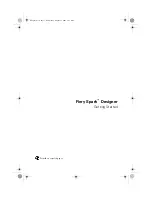
E CLASS TAPE DEFINEs
This appendix lists the attributes that can be used in a DEFINE of CLASS TAPE for labeled-tape
processing. For more information about creating DEFINEs, see the TACL Reference Manual and
the Guardian User's Guide.
NOTE:
You can also use CLASS TAPECATALOG DEFINEs to request scratch tapes for new tape
files and cataloging of new tape files, and to access cataloged tape files. For more information,
see the DSM/Tape Catalog User's Guide.
TAPE DEFINE Attributes
The TAPE DEFINE attributes are listed in alphabetical order and their syntax is provided. For the
rules that apply to each of the TAPE DEFINE attributes, see
Table 20: TAPE DEFINE Consistency
Rules (page 291)
.
BLOCKLEN block-length
specifies the data block size in bytes. If the RECFORM attribute is F, BLOCKLEN must be a
multiple of the RECLEN attribute value.
BLOCKLEN is valid but ignored by Backup and Restore 2.0. The internally used value of
BLOCKLEN will always be the default or user-specified value of the BLOCKSIZE job option.
CLASS attribute
works as a DEFINE subtype. You must specify TAPE as the attribute of CLASS to use the DEFINE
attributes for labeled-tape processing. The CLASS TAPE working attribute set consists of all the
attributes discussed in this appendix.
DENSITY { 800] | 1600 | 6250 }
specifies the tape density in bits per inch (bpi). The specified value appears in the mount
messages sent to the operator. The default is the current setting of the tape drive. For guidelines
on setting tape density, see the SCF Reference Manual for the Storage Subsystem.
DENSITY is not supported by Backup and Restore 2.0.
DEVICE { $device | \remote-node.$device }
specifies the name of the tape device where the tapes are mounted. If you specify a tape unit
on a remote node, the remote node must be a node on your system network. If you name a
specific device, the $ZSVR tape process does not support queuing when more than one process
opens that tape drive. To avoid queuing problems, omit specific device names.
If you do not name a specific device, the $ZSVR tape process chooses an appropriate tape
drive.
If the DEFINE does not include DEVICE or SYSTEM, tapes must be mounted on a local node.
You cannot specify both the DEVICE and SYSTEM attributes.
EBCDIC { IN | OUT | ON | OFF }
specifies whether data on an IBM labeled tape is translated.
IN—data records read from the tape file are translated from EBCDIC to ASCII.
OUT—data records written to tape are translated from ASCII to EBCDIC.
ON—both IN and OUT; this is the default for IBM tapes.
OFF—data records are not translated.
EBCDIC is not supported by Backup and Restore 2.0.
EXPIRATION date
specifies the date that the files on the labeled tape can be overwritten. Specify the month, day,
and year (for example, DEC 31 1992). If you specify EXPIRATION, you cannot specify the
RETENTION attribute. If the DEFINE does not include EXPIRATION or RETENTION, the tape
expiration date defaults to the following day (RETENTION = 1 is added to the DEFINE).
288 CLASS TAPE DEFINEs
















































